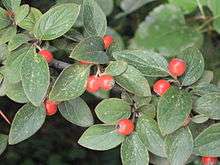Cotoneaster franchetii
Cotoneaster franchetii (Franchet's cotoneaster or orange cotoneaster) is a species of Cotoneaster native to southwestern China, in the provinces of Guizhou, Sichuan, Xizang, and Yunnan, and also in adjacent northern Myanmar and northern Thailand.[1][2]
| Cotoneaster franchetii | |
|---|---|
 | |
| Scientific classification | |
| Kingdom: | Plantae |
| Clade: | Tracheophytes |
| Clade: | Angiosperms |
| Clade: | Eudicots |
| Clade: | Rosids |
| Order: | Rosales |
| Family: | Rosaceae |
| Genus: | Cotoneaster |
| Species: | C. franchetii |
| Binomial name | |
| Cotoneaster franchetii Bois, 1902 | |
It is an evergreen or semi-evergreen shrub growing to 3 metres (9.8 ft) tall. The leaves are oval-acute, 2–3.5 centimetres (0.79–1.38 in) long and 1–1.5 centimetres (0.39–0.59 in) broad, shiny green above, pubescent below with dense whitish to yellowish hairs. The flowers are produced in corymbs of 5–15 together, each flower 6–7 millimetres (0.24–0.28 in) diameter, with the five petals pink on the outer side, white on the inner side. The fruit is a red pome 6–9 millimetres (0.24–0.35 in) diameter; they are eaten by fruit-eating birds, which disperse the seeds in their droppings.[1][3][4]
Two varieties are accepted by some authors,[4] but not treated as distinct by the Flora of China:[1]
- Cotoneaster franchetii var. franchetii. Described above.
- Cotoneaster franchetii var. cinerascens Rehd. Larger, to 4 metres (13 ft) tall, with leaves up to 4 centimetres (1.6 in) long, and up to 30 flowers per corymb.
Some authors include a third variety, var. sternianus,[2] though this is more often treated as a distinct species Cotoneaster sternianus.[4][5]
Cultivation and uses
Cotoneaster franchetii is a popular ornamental plant. It has escaped from cultivation and become locally naturalised in parts of the British Isles and the Pacific Northwest of North America.[3][4]
References
- "Cotoneaster franchetii". Flora of China. Retrieved August 21, 2007.
- "Cotoneaster franchetii". Germplasm Resources Information Network (GRIN). Agricultural Research Service (ARS), United States Department of Agriculture (USDA). Retrieved August 21, 2007.
- Flora of NW Europe: Cotoneaster franchetii Archived 2016-03-04 at the Wayback Machine
- Huxley, A, ed. (1992). New RHS Dictionary of Gardening. Macmillan. ISBN 0-333-47494-5.
- Flora of NW Europe: Cotoneaster sternianus Archived 2013-07-29 at Archive.today